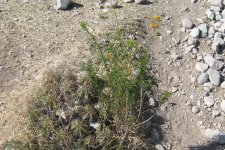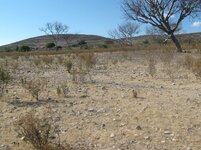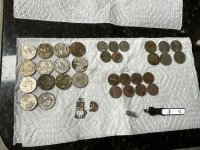I will try tomorrow or when I can. I added it to my list. If there is a way corn cobs can look fresh when they are not, I am willing to be corrected. Thanks for tip.
You are using an out of date browser. It may not display this or other websites correctly.
You should upgrade or use an alternative browser.
You should upgrade or use an alternative browser.
Aztec Gold - how and where they might have acquired it
- Thread starter Highmountain
- Start date
http://www.flickr.com/photos/12150532@N04/4569251816/
Here is a picture of what is believed to be an ancient corn cob. It is pretty much what I would expect an ancient corn cob to look like, both in size and condition, IF it were in a well protected place. I would say also in color, but I really do not know what to think about color, since it seems to be a genetic variable. But, other pictures also showed the color which is called white here in Mexico.
Here is a picture of what is believed to be an ancient corn cob. It is pretty much what I would expect an ancient corn cob to look like, both in size and condition, IF it were in a well protected place. I would say also in color, but I really do not know what to think about color, since it seems to be a genetic variable. But, other pictures also showed the color which is called white here in Mexico.
distribuidorUSA
Full Member
- Dec 11, 2012
- 148
- 34
- Detector(s) used
- Whites DFX.
- Primary Interest:
- All Treasure Hunting
Since the Aztecs did not know how to separate Metals from ores.the gold artifacts they made came from placer gold.and the region rich enough to supply the Aztec empire is situatedto the South East of Mexico City.I actually recovered a small nugget from a stream.Hystory tells us that when the Spaniards came to this region they were presented with Jicaras (squash bowls) full of gold.the placers are still rich in gold since they were exploited using rudimentary methods.even the hills around this region have gold in quartz veins.I might try to exploite some of it in the future.right now it's not safe enough.
My reading also indicated SE of Mexico City, perhaps in the Izucar de Matamoros general area, but more than a small area.
The use of metallurgy by the Aztecs is a controversial topic. Somewhere on here is an ancient drawing of what looks like a bellows system used on gold by Aztec workers. This has been a year or two so my memory is not perfect.
A man I know told me in that general area local indigenous folks were still mining gold in the early 20th Century. He said they used that black rock as wedges, obsidian? And, it will break the somewhat soft rock. He told me where they get obsidian, I forget, isn't that volcanic?
Travertine marble is common in that part of Mexico, though I have not been to that exact location. Travertine can be very hard and brittle, or it can be soft. He also told me there is a plant or herb which can be placed on stone to soften it up, but I know no details.
Of course, modern quarrying in that general part of Mexico uses nitrogen fertilizer and fuel oil, excited by small quantities of dynamite. It makes a lovely thump when it goes off. (N is slow, so it is more of a thump than a BANG. At least, that is what it sounds like to me, though I do not have a strong musical skill.)
The Aztecs also received gold as tribute from conquered tribes.
I do not understand about safety now. Do you mean close to Popo and safety issues resulting from eruptions?
Or, do you mean Zetas? They do not usually roam the hills looking for people digging in the ground. Nor do druggies have a strong presence in that area. In fact, an educated man told me they put their families in that part of Mexico, to keep them safe from the violence.
In truly rural areas in that part of Mexico, you have two problems. A lot of that land is ejido, or communal land, and the people who belong to the ejidos are somewhat aggressive about running intruders off. If you go there, you can be sure someone is watching you, even if you don't see them.
Likewise, some of the land where gold was found by digging into rocks is now Federally protected archeological zone. Think Federal prison, hint, hint.
Of course it depends up exactly where you mean. I don't tell where I live, except that local legends insist that Moctezuma's treasure was buried here. Which helps you not at all, heh, heh. So, I don't expect you to tell where you wish to dig.
The use of metallurgy by the Aztecs is a controversial topic. Somewhere on here is an ancient drawing of what looks like a bellows system used on gold by Aztec workers. This has been a year or two so my memory is not perfect.
A man I know told me in that general area local indigenous folks were still mining gold in the early 20th Century. He said they used that black rock as wedges, obsidian? And, it will break the somewhat soft rock. He told me where they get obsidian, I forget, isn't that volcanic?
Travertine marble is common in that part of Mexico, though I have not been to that exact location. Travertine can be very hard and brittle, or it can be soft. He also told me there is a plant or herb which can be placed on stone to soften it up, but I know no details.
Of course, modern quarrying in that general part of Mexico uses nitrogen fertilizer and fuel oil, excited by small quantities of dynamite. It makes a lovely thump when it goes off. (N is slow, so it is more of a thump than a BANG. At least, that is what it sounds like to me, though I do not have a strong musical skill.)
The Aztecs also received gold as tribute from conquered tribes.
I do not understand about safety now. Do you mean close to Popo and safety issues resulting from eruptions?
Or, do you mean Zetas? They do not usually roam the hills looking for people digging in the ground. Nor do druggies have a strong presence in that area. In fact, an educated man told me they put their families in that part of Mexico, to keep them safe from the violence.
In truly rural areas in that part of Mexico, you have two problems. A lot of that land is ejido, or communal land, and the people who belong to the ejidos are somewhat aggressive about running intruders off. If you go there, you can be sure someone is watching you, even if you don't see them.
Likewise, some of the land where gold was found by digging into rocks is now Federally protected archeological zone. Think Federal prison, hint, hint.
Of course it depends up exactly where you mean. I don't tell where I live, except that local legends insist that Moctezuma's treasure was buried here. Which helps you not at all, heh, heh. So, I don't expect you to tell where you wish to dig.
pippinwhitepaws
Banned
- Jan 2, 2013
- 4,541
- 1,971
- Detector(s) used
- Whites prism III
- Primary Interest:
- Relic Hunting
Maize - History and Domestication of American Corn
Corn Domesticated From Mexican Wild Grass 8,700 Years Ago ? News Watch
corn was domesticated in central america/north america...
potatoes/tomatoes were domesticated in south america
Corn Domesticated From Mexican Wild Grass 8,700 Years Ago ? News Watch
corn was domesticated in central america/north america...
potatoes/tomatoes were domesticated in south america
Real de Tayopa Tropical Tramp
Gold Member
G'afteroon pie: You posted --> Travertine marble is common in that part of Mexico, though I have not been to that exact location. Travertine can be very hard and brittle, or it can be soft. He also told me there is a plant or herb which can be placed on stone to soften it up, but I know no details.
Interesting since, I believe that col Fawcett also mentioned that he had walked through field of a fleshy plants that disolved his metalic spurs, and rumors exist, that there is a fleshy plant that will soften granite etc, supposedly this is what the Incas used to soften the rocks so that they could be fitted as as closely as they are. Impossile to do this in any other manner since often there are apposing angles..
Don Jose de La Mancha
Interesting since, I believe that col Fawcett also mentioned that he had walked through field of a fleshy plants that disolved his metalic spurs, and rumors exist, that there is a fleshy plant that will soften granite etc, supposedly this is what the Incas used to soften the rocks so that they could be fitted as as closely as they are. Impossile to do this in any other manner since often there are apposing angles..
Don Jose de La Mancha
I will TRY to remember to ask him what it was.
When he was 10 years old, his father sent him to the outdoors with the family goats. Day and night for 7 years. At one point, he was allowed to come in, in the morning, put on clean clothes, and go to school for a few hours. That lasted about 2 years.
He was sent food, but during the growth spurt, he learned to subsidize his diet from the natural plants. He knows plants. People come to him and ask for medicine from plants.
He is the one who told me about a plant which, when given to dogs, makes them immune to rabies. I was rather excited when I heard that. But, he informed me that plant kills humans and goats. Sigh.
By the way, my wife confirmed that anti-rabies plant. She is quite a bit older than he and she remembers when the family discovered the plant. They had a dog which killes dogs with rabies and they wondered how he managed to keep from being bitten. When they realized he was being bitten but did not get rabies, they watched him all day, and he was taking bites of the fruit of that plant. By such observations, I theorize have come many medicines over the millenia.
When he was 10 years old, his father sent him to the outdoors with the family goats. Day and night for 7 years. At one point, he was allowed to come in, in the morning, put on clean clothes, and go to school for a few hours. That lasted about 2 years.
He was sent food, but during the growth spurt, he learned to subsidize his diet from the natural plants. He knows plants. People come to him and ask for medicine from plants.
He is the one who told me about a plant which, when given to dogs, makes them immune to rabies. I was rather excited when I heard that. But, he informed me that plant kills humans and goats. Sigh.
By the way, my wife confirmed that anti-rabies plant. She is quite a bit older than he and she remembers when the family discovered the plant. They had a dog which killes dogs with rabies and they wondered how he managed to keep from being bitten. When they realized he was being bitten but did not get rabies, they watched him all day, and he was taking bites of the fruit of that plant. By such observations, I theorize have come many medicines over the millenia.


We were out walking in a different town, when I asked him about the plant. Right in front of us were the plants. He indicated, though, that they did not eat into the rock. They acted as a shock absorber which made the blow more effective. I am not really convinced of this, but he does have a way of being right.
It does look sort of like a first cousin to goldenrod we had been in the US.
Top Member Reactions
-
 2310
2310 -
 1122
1122 -
 1041
1041 -
 898
898 -
 836
836 -
 770
770 -
 755
755 -
 739
739 -
 606
606 -
 508
508 -
 494
494 -
 476
476 -
 447
447 -
 420
420 -
O
399
-
 398
398 -
 397
397 -
 392
392 -
 384
384 -
 376
376
Users who are viewing this thread
Total: 2 (members: 0, guests: 2)



